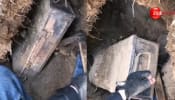London: Scientists have discovered the oldest known blood cells in the wounds of Otzi, the stone age “Iceman” whose body was found on an Alpine mountainside after being preserved in ice 5,300 years ago.
After his severely wounded and bruised corpse was discovered by hikers near the Italian-Austrian border in 1991, Otzi was dubbed the “victim of the world’s oldest murder puzzle”.
Scientists have since pored over his clothes, his body and even sequenced his DNA to discover the man’s age, his state of health and even what he ate for his last meal.
Now, the discovery of red blood cells in his wounds – the oldest blood traces ever found – has provided further evidence of exactly how Otzi met his end, a newspaper reported.
Using an atomic force microscope, the team studied thin layers of tissue at the point where an arrow had pierced Otzi’s back, and on a deep cut on his right hand.
By probing every tiny point on the tissue they built up a three-dimensional image of the tissue, which blood cells with the same distinctive doughnut-like appearance as those found in healthy people today, and traces of fibrin, a blood clotting protein.
The discovery of a flint arrowhead in his shoulder in 2001, together with other bruises and wounds, had already indicated that Otzi was attacked before his death, but it had been unclear whether he died at the scene, or whether he crawled to his mountainside grave after fleeing his enemies and died from exhaustion or bleeding.
“Because fibrin is present in fresh wounds and then degrades, the theory that Otzi died straight after he had been injured by the arrow, as had once been mooted, and not some days after, can no longer be upheld,” said Dr Albert Zink, of the Institute for Mummies and the Iceman in Bolzano, Italy.
Previous studies of Otzi’s naturally mummified body have already found that he was about 159cm tall (5ft, 2.5in) and at 46 years old was at a relatively advanced stage of life.
Researchers discovered the man – possibly a warrior – suffered with hardened arteries and tooth cavities and had eaten a meal of ibex shortly before his death, while they speculated that tattoos on his spine and right leg might have been a primitive attempt to overcome his arthritis.
Sequencing of his DNA also revealed that he had brown eyes and type “O” blood, was lactose intolerant, and was more closely related to modern-day Corsicans or Sardinians than people living in the Alps near where his body was found.
ANI















